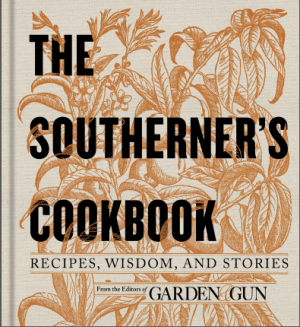
The Southerner’s Cookbook by the editors of Garden & Gun magazine will be released this Tuesday, October 27. To celebrate the release, I spent a morning in the kitchen with Athens chef Peter Dale (University of Georgia alumnus) to test out a few of the recipes. This coastal Georgia girl selected two fall favorites, Oyster Stew and Southern Skillet Cornbread, and Peter sourced the fresh ingredients from his Athens restaurants, The National and Seabear Oyster Bar. While preparing the dishes, Peter and I enjoyed discussing the people and places that make up the fabric of Southern cuisine to us. I love that so much of that fabric is captured in the pages of this new cookbook.
The cookbook features 300+ pages of treasured Garden & Gun recipes and essays that showcase the South’s culinary past and present. Cookbook contributors include James Beard Award-winning chefs John Currence and Hugh Acheson and because I attended both Ole Miss and the University of Georgia, these renowned Oxford and Athens chefs hold special affinity for me. In fact, Peter and Hugh are partners in The National and have together helped cultivate Athens as a celebrated foodie town.
In addition to the stories the recipes tell in the cookbook, essays from some of my favorite authors are sprinkled in for added flavor. One of my favorites is the selection shared below, Your First Oyster by Rick Bragg.
Enjoy our taste of The Southerner’s Cookbook and be sure to pick up your own copy this week in your favorite indie bookshop or pre-order here now.
Recipes from The Southerner’s Cookbook prepared by University of Georgia graduate and Athens Chef Peter Dale of The National, Condor Chocolates, Seabear Oyster Bar || Photography Danielle Hulsey + Styling Candice Beaty || Aprons + Linens from Heirloomed Collection || Pots from Le Creuset + Lodge Cast Iron || Herbs + Vegetables from Woodland Farms + Sundance Farm || Louisiana Cajun Pork Andouille Sausage from Comeaux’s
for guide2athens + The Southern Coterie
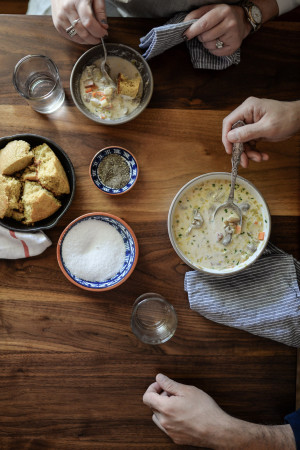
APALACHICOLA OYSTER STEW
serves 4 as an entree or 6 as an appetizer
TO TRACE THE TRAJECTORY OF OYSTER STEW IN THE SOUTH, PICK YOUR possible thread—Irish
immigrants to the Chesapeake and the hills beyond reproducing a creamy dried-fish stew of their European homeland with abundant North American ingredients, or German immigrants bringing their dairy-based
traditions to Louisiana’s Creole country. This version meets roughly in the geographic middle, taking inspiration from Florida’s Panhandle region, where the rich stew is made with plump Apalachicola Bay oysters, although you can use any variety of quality fresh oysters you like. Add them just before serving to gently heat through. Concentrated oyster liquor and clam juice lend an extra element of brine, while Conecuh sausage from the just-inland town of Evergreen, Alabama, delivers smoke and spice.
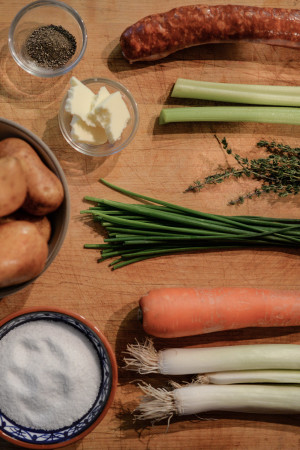
I N G R E D I E N T S
1 tablespoon unsalted butter
2 teaspoons vegetable oil
2 ounces smoked sausage, such as Alabama-made Conecuh, diced (about ¼ cup)
½ cup diced leeks, white and light green parts only
1 carrot, peeled and diced
½ celery stalk, diced
½ cup finely diced new potatoes (2 or 3 potatoes)
1 fresh thyme sprig
½ teaspoon kosher salt
¼ teaspoon freshly ground black pepper
2 pints freshly shucked oysters with liquor
¼ to 1⁄3 cup dry white wine
1 (8-ounce) bottle clam juice
2 cups half-and- half
½ teaspoon Worcestershire sauce
½ teaspoon hot sauce, plus more for serving
Chopped fresh parsley or chives for garnish
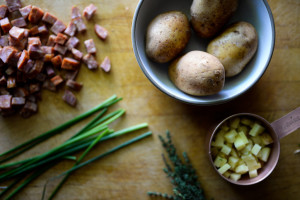
P R E P A R A T I O N
Melt the butter in the oil in a Dutch oven over medium-high heat. Add the sausage and cook, stirring, until browned, about 3 minutes. Add the leeks, carrot, celery, potatoes, thyme, salt, and pepper and cook, stirring occasionally, for 5 minutes to soften the vegetables.
Drain the oysters in a fine-mesh sieve set over a glass measuring cup to collect their liquor. Add an equal amount of wine to oyster liquor. Pour the liquor mixture into a small saucepan, place over medium-high
heat, and reduce by half, about 2 minutes. Transfer the reduction to the pan with the vegetables. Reduce the heat to medium-low and add the clam juice, half-and- half, Worcestershire sauce, and hot sauce to the pan.
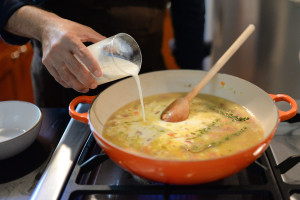
Bring to a simmer and simmer for 10 to 15 minutes, until the potatoes are tender, watching the pan carefully to make sure the liquid doesn’t boil, which would cause the half-and-half to break. Slip the oysters into the liquid and cook for 1 to 2 minutes more, until barely warmed through. Remove thyme stem.
Ladle into bowls and serve garnished with parsley and hot sauce.
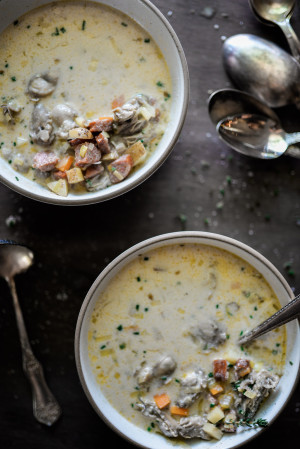
SOUTHERN SKILLET CORNBREAD
serves 8-12
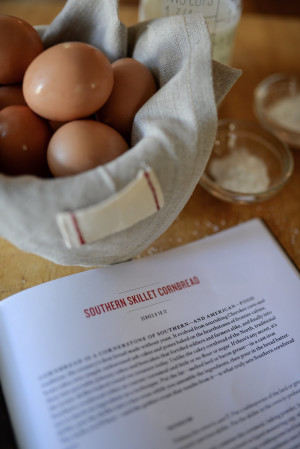
CORNBREAD IS A CORNERSTONE OF SOUTHERN—AND AMERICAN—FOOD tradition: the country’s first bread made without yeast. It evolved from nourishing Cherokee corn-and- bean cakes into simple unleavened ash cakes and pones baked on the hearthstones of frontier cabins, then into portable Johnny cakes and hoecakes that fortified soldiers and farmers alike, and finally into the iconic skillet-baked round we treasure today. Unlike the cakey cornbread of the North, traditional Southern cornbread relies on coarser cornmeal and little or no flour or sugar. If there’s any secret, it’s not so much an ingredient as a technique. Put the fat—melted lard or bacon grease—in a cast-iron skillet, put the skillet into a hot oven while you assemble the ingredients, then pour in the bread batter. The sizzle you’ll hear—and the golden crust that results from it—is what truly sets Southern cornbread apart.
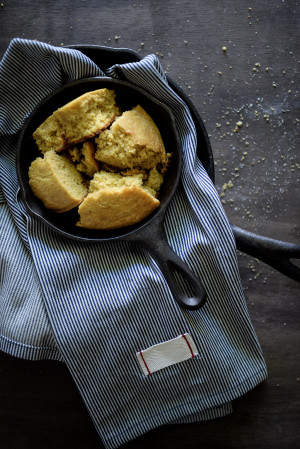
I N G R E D I E N T S
4 tablespoons melted lard or bacon grease
2 cups good-quality coarse-ground yellow cornmeal, such as McEwen & Sons or Anson Mills
1 teaspoon baking powder
1 teaspoon baking soda
1 teaspoon kosher salt
2 large eggs
1½ cups buttermilk
P R E P A R A T I O N
Preheat the oven to 400˚F. Put 2 tablespoons of the lard or grease in an 10-inch cast-iron skillet. Put the skillet in the oven to preheat.
In a large bowl, combine the cornmeal, baking powder, baking soda, and salt. In a separate bowl or liquid measuring cup, whisk the eggs, buttermilk, and the remaining 2 tablespoons lard together, mixing well to combine. Pour the liquid ingredients into the dry ingredients, stirring just until incorporated. Do not overmix.
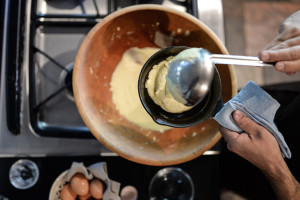
Carefully remove the hot skillet from the oven and swirl the melted fat to coat the bottom and sides. Pour the batter into the pan and return it to the oven to bake for 20 to 25 minutes, until the bread is golden on top and has pulled away from sides of the pan slightly. (A toothpick inserted in the center should come out clean.) Slice and serve.
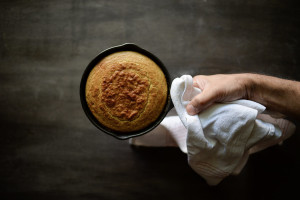
Y O U R F I R S T O Y S T E R
It’s usually not love at first sight, but then you understand what all the fuss is about
RICK BRAGG
THE FIRST ONE I ATE TASTED LIKE RIVER MUD. It was not that earthy, pungent, essence du monde that well-traveled people like to go on about over their quenelles aux huîtres. It tasted like wet dirt, only slicker, fishier, like what a tadpole would taste like if you sucked it right out of the ditch, or a wet hoof print.
Of course, I was not a gourmand then. I was a sun-scorched boy in a dockside restaurant in Panama City, intoxicated by the aroma of coconut butter suntan lotion and piña colada lip balm, and flabbergasted by ten thousand teenage Baptists in tiny two-piece bathing suits. I wanted to eat oysters because it seemed like a thing a man of the world would do in 1971, like being a spy against the Communists or owning an MGB. But that taste, and that horrible consistency—somewhere among raw chicken liver, Jell-O, beef tripe, and Dippity-do— haunted me for years.
“What does one look like?” one of my brothers asked me at the time.
“Well,” I said, “it’s gray-lookin’.”
“What does it taste like?” he asked.
“Well,” I said, “it’s . . . it’s . . .” but it was just beyond me then.
How could people eat something I could not even say? Maybe, I remember thinking, they might not be so damn awful if they were cooked. I mean, I suspect that a pork chop would be pretty grim if you had to eat it while the hog was still kicking. But later, in high school, one of my mean girl cousins gave me a fried one from her seafood platter, and even though it was entombed in batter and well and truly dead, it still tasted like tadpole, but crunchier this time.
I spit that one out. At least back then, I did not have to pretend to like them to fit in. That came later, when I became a writer.
There are just some things that male writers of a certain ilk feel they have to do. I call it the Curse of Hemingway. We have to like to fish. We have to be proficient in blowing birds from the sky with shotguns. And we have to love oysters. We have to sit around a table in some sun-blasted shack on some desolate, mosquito-infested cay and slurp ’em right out of the shell. Or they take our vowels away.
I love to fish. I am not good at it, but I love it. In my youth, I slaughtered some birds, though it seemed like a lot of firepower to get a few mouthfuls of meat—and I still think quail hunting is just an excuse for biscuits and gravy. Then my wife put a dozen bird feeders in our backyard, cooed over finches, hummingbirds, and cardinals, and made me deeply ashamed.
But even as I got a more sophisticated palate, I could only tolerate oysters. Oh, I put up a good front. Any real man can eat one oyster, two, even three. He just bellies up to it, chews, and gulps. There were worse things. Snails, I guess. Sushi. Turkey bacon.
But I could not make myself like them in my first forty years. I thought moving to Florida, twice, would at least break down my resistance. But that too had no real impact, and the young, oyster-hating man I was vanished into old age.
The change, when it did come, almost made me believe in magic. And like most magic, here in my South, it happened in New Orleans.
I remember the moment. I believe I was sitting in a cool, dark place in the French Quarter, one of those places that Katrina would drown and remove forever from all but fond memory. It was fall, which means it was only eighty-nine in the shade, and as I recall I was mildly drunk on brown whiskey, though it could have been some fruity rum drink and I am just embarrassed to say.
I went in for some crawfish bisque, not the creamy kind but a gumbo-like concoction that was redolent with onions, peppers, and little bitty crawfish heads stuffed with, well, stuffing. It was a reason to live.
I do not know why I ordered the oysters—maybe because I saw the words half dozen and thought this might be my chance to try them again and not be so wasteful. I did not try to slurp them from the shell, but carefully prepared them in the fashion I was told my grandfather ate them when he drifted down to the Florida Gulf coast in the 1950s to roof houses, fish, sleep on the sand, and eat things he could not find in the foothills of the Appalachians.
I took a saltine, plopped down an oyster, forked on some cocktail sauce, daubed on a fingernail-size spot of horseradish, squeezed a lemon over the whole mess, and popped it in my mouth.
Like I said, it had to be magic. One minute you hate, the next you love. But it was good. I know that oyster purists will say I did not truly taste the oyster, that I am a commoner, but they can kiss my ass.
The cocktail sauce and horseradish did not mask the oyster, only provided a little misdirection, a little sleight of hand, and I chewed and liked it. They say you can taste the sea in it, and I think that is true. I even ate the last one naked, with just a little lemon, and it was pretty fine. It had to be New Orleans, I believed. In New Orleans, you walk on roads flecked with crushed oyster shells, and there is a whole culture of oysters, a mystique. Oyster recipes and oyster lore naturally pooled there, some of them indigenous, some trickling down from other places.
“One time my mother bit down on one and there was a pearl in it,” says Jim Davis, director of the Center for the Book at the State Library of Louisiana. “My daddy took it and made her a ring out of it. We don’t know if the fact that it was cooked made it any less valuable.”
In New Orleans, oysters are almost an art form. You eat them covered in spinach and garlic and bacon and cheese; you eat them roasted, baked, even grilled over an open flame in their shells.
And I came to like them all. At Upperline, one of the great restaurants of this world, I ate them in oyster stew, in heavy cream, but you could have dropped a coaster in there instead and it probably still would have tasted pretty good.
In a half dozen kitchens around town, I had them in oyster dressing, which I consumed in such quantities I wanted to die, and in gumbo so good you would pray, quietly, that the cook would say, “Babe, you want me to put this in some Tupperware, so you can take some home?” And of course, all over town, I ate them in po’ boys and oyster loaves, dripping with hot sauce and tartar sauce, with cold root beer on the side. I was not just eating food, I was consuming culture, and as I came to love the city, I came to love its oysters.
But it was not just the place, as it turned out. Once my resistance was broken, I ate them in Florida, I ate them on the Alabama coast, and I loved them there too. Maybe there is no magic to it at all. Maybe—as my momma always told me—as I get older I come to appreciate more of the world around me. Someday, she told me, I will even like butter beans.
A few years ago I got to eat dinner with one of the great writers of our time at one of the great restaurants of our time, Highlands Bar and Grill in Birmingham. Pat Conroy ate about ten oysters, with nothing but a smile.
I ate four, four of the best oysters I’ve ever had, and prepared one more—in the way my grandfather ate them—for my fifteen-year- old stepson, Jake. He gasped and choked only slightly, and fought it down.
“I know, son,” I said, and gave him a pat.
“It will,” I said, “get better.”
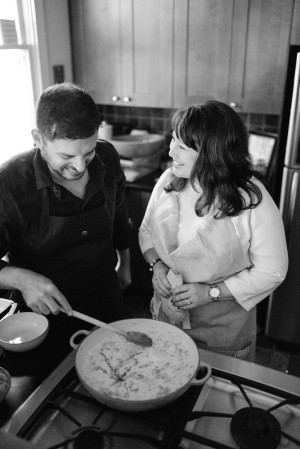

[su_spacer size=”40″] Make sure to check out Bulldawg Illustrated’s latest print edition: Trick or Treat, digital issue available for free online. CLICK HERE.
[su_spacer size=”80″]






